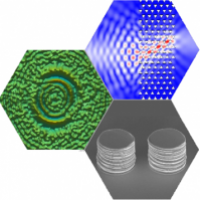Band gaps and waveguiding of surface acoustic waves in pillars-based phononic crystals
Abstract :
After an overview of the different computational methods dedicated to modeling propagation in phononic crystals, we present, in this work, the features of the interaction between surface acoustic wave and locally-resonant pillar on the top of semi-infinite medium.We showed that the phononic crystal we proposed possess an acoustic metamaterial feature for surface acoustic waves in the manner that the pillars on the top of the surface introduced new guided modes in the non-radiative region of the substrate outside sound cone. We also demonstrate that these guided modes are resonant modes that have frequencies greatly lower than those expected from the Bragg mechanism. In addition, the All-Angle Negative Refraction (AANR) effect for surface acoustic waves in our 2D structure has been achieved through two completely different mechanisms by altering geometrical parameters. Furthermore, one flat lensesis designed for each of the two mechanisms to allow focusing of an acoustic point source into an image. We showed that the imaging resolutions we obtain beat the Rayleigh diffraction limit. We studied in the last part of this work the mechanism of waveguiding surface phonons through locally-resonant defect inserted in 2D perfect pillar-based phononic crystal as well as a one-dimensional locally-resonant pillars as a chain deposited on a semi-infinite substrate. We demonstrated in both cases the possibility to allow waveguiding of surface phonons that spatially confine their elastic energy in sub-wavelength apertures. We also elucidate the mechanisms that are behind sub-wavelength wave guidance and confinement of surface phonons.
keywords: Phononic crystal, surface acoustic wave, acoustic sub-wavelength superlensing, band gab, resonant-mode waveguiding

